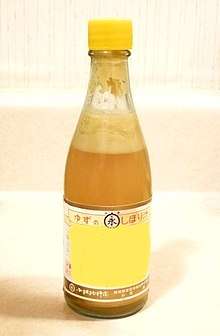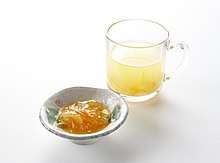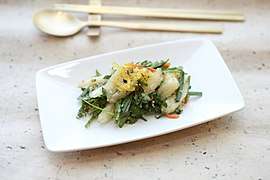Yuzu
Yuzu (Citrus junos, from Japanese 柚子 or ユズ) is a citrus fruit and plant in the family Rutaceae of East Asian origin. It is believed to have originated in central China as a hybrid of mandarin orange and the ichang papeda.
| Yuzu | |
|---|---|
.jpg) | |
| Scientific classification | |
| Kingdom: | Plantae |
| Clade: | Tracheophytes |
| Clade: | Angiosperms |
| Clade: | Eudicots |
| Clade: | Rosids |
| Order: | Sapindales |
| Family: | Rutaceae |
| Genus: | Citrus |
| Species: | C. junos |
| Binomial name | |
| Citrus junos | |
The yuzu is called yuja (from Korean 유자) in Korean cuisine. Both Japanese yuzu and Korean yuja are borrowings of the Chinese youzi (柚子), though this Chinese word now refers to the pomelo.
Description
The fruit looks somewhat like a small grapefruit with an uneven skin, and can be either yellow or green depending on the degree of ripeness. Yuzu fruits, which are very aromatic, typically range between 5.5 cm (2.16 in) and 7.5 cm (2.95 in) in diameter, but can be as large as a regular grapefruit (up to 10 cm (3.93 in) or larger).
Yuzu forms an upright shrub or small tree, which commonly has many large thorns. Leaves are notable for a large, leaf-like petiole, resembling those of the related kaffir lime and ichang papeda, and are heavily scented.
Yuzu closely resembles sudachi (a Japanese citrus from Tokushima Prefecture, a yuzu–mandarin orange cross) in many regards, though unlike the sudachi, yuzu eventually ripen to an orange colour and there are subtle differences between the flavours of the fruit.
 Citrus junos fruits and cross sections
Citrus junos fruits and cross sections The leaves have large leaf-like petioles.
The leaves have large leaf-like petioles.- Yuzu (left) compared to mandarin orange (right)
Cultivation
The yuzu originated and grows wild in central China and its Tibet region. It was introduced to Japan and Korea during the Tang dynasty, and is still cultivated there.[1] It grows slowly, generally requiring 10 years to fruit. To shorten duration to fruiting, it may be grafted with karatachi (P. trifoliata). It is unusual among citrus plants in being relatively frost-hardy, due to its cold-hardy Ichang papeda ancestry, and can be grown in regions with winters as low as −9 °C (15 °F) where more sensitive citrus would not thrive.
Varieties and similar fruits
In Japan, an ornamental version of yuzu called hana yuzu (花柚子, 花ゆず) "flower yuzu" is also grown for its flowers rather than its fruit. A sweet variety of yuzu known as the yuko, only present in Japan, became severely endangered during the 1970s and 1980s; a major attempt has been made to revive this varietal in southern Japan.[2] Another variety of yuzu in Japan, with knobby skin, is called shishi yuzu (獅子柚子, literally "lion yuzu").[3]
Dangyuja, a Korean citrus fruit from Jeju Island, is often considered a type of yuzu due to its similar shape and flavour, but it is genetically a variety of pomelo.
Use
East Asia
Culinary use
Japan

Though rarely eaten as a fruit, yuzu is a common ingredient in Japanese cuisine, where the aromatic zest (outer rind) as well as juice are used much in the same way that lemons are used in other cuisines. The yuzu's flavour is tart and fragrant, closely resembling that of the grapefruit, with overtones of mandarin orange.
It is an integral ingredient (along with sudachi, daidai, and other similar citrus fruits) in the citrus-based sauce ponzu, and yuzu vinegar is also produced. Yuzu is often combined with honey to make yuzu hachimitsu (柚子蜂蜜)—a kind of syrup that is used to make yuzu tea (柚子茶), or as an ingredient in alcoholic drinks such as the yuzu sour (柚子サワー).[4] Yuzu kosho (also yuzukosho, literally "yuzu and pepper"), is a spicy Japanese sauce made from green or yellow yuzu zest, green or red chili peppers, and salt.
It is used to make liquor (such as yuzukomachi, 柚子小町) and wine.[5][6] Slivered yuzu rind is used to garnish a savoury, salty egg-pudding dish called chawanmushi, as well as miso soup.[7] It is often used along with sudachi and kabosu.
Yuzu is used to make various sweets including marmalade and cake. It is used extensively in the flavouring of many snack products, such as Doritos.[8][9][10]
Korea
In Korean cuisine, yuja is most commonly used to make yuja-cheong (유자청, yuja marmalade) and yuja tea. Yuja-cheong can be made by sugaring peeled, depulped, and thinly sliced yuja, and yuja-cha (yuja tea) can be made by mixing hot water with yuja-cheong. Yuja-hwachae (유자화채, yuja punch), a variety of hwachae (fruit punch), is another common dessert made with yuja. Yuja is also a common ingredient in Korean-style western food, such as salads.[11]
 Yuja tea and yuja-cheong
Yuja tea and yuja-cheong Deodeok yuja salad
Deodeok yuja salad Yuja bread sold in Yeosu
Yuja bread sold in Yeosu
Other uses
Yuzu is also known for its characteristically strong aroma, and the oil from its skin is marketed as a fragrance. In Japan, bathing with yuzu on Tōji, the winter solstice, is a custom that dates to at least the early 18th century.[12][13][14] Whole yuzu fruits are floated in the hot water of the bath, sometimes enclosed in a cloth bag, releasing their aroma.[15] The fruit may also be cut in half, allowing the citrus juice to mingle with the bathwater. The yuzu bath, known commonly as yuzu yu (柚子湯), but also as yuzu buro (柚子風呂), is said to guard against colds, treat the roughness of skin,[13] warm the body, and relax the mind.
The body of the taepyeongso, a Korean traditional oboe, close to the Chinese Suona or the Zurna, is often made from jujube, mulberry or yuzu wood.
Elsewhere
Beginning in the early 21st century, yuzu has been increasingly used by chefs in the United States and other Western nations, achieving notice in a 2003 article in The New York Times.[16]
In the United States the Department of Agriculture banned the import of fresh yuzu from abroad — both the fruit and the trees.[17]
References
- "Yuzu ichandrin (papeda hybrid). Citrus junos Sieb. ex Tanaka. Citrus ichangensis X C. reticulata var. austere". Citrusvariety.ucr.edu. Retrieved 2012-11-17.
- Kurokawa, Yoko (January 7, 2009). "The Yuko, a Native Japanese Citrus". The Tokyo Foundation.
- photo
- 5分. "柚子サワー | ホームクッキング【キッコーマン】". Kikkoman.co.jp. Retrieved 2012-03-04.
- Archived November 15, 2006, at the Wayback Machine
- Archived September 28, 2007, at the Wayback Machine
- Janet Fletcher (May 31, 2006). "Yuzu & Huckleberry, Flavors of the Moment: How these and other obscure ingredients end up on so many Bay Area menus". SFGate / San Francisco Chronicle.
- Phro, Preston (22 September 2015). "New citrus-yuzu-salt-flavored Jagariko potato sticks are delicious, cheap, and ultra-limited". Sora News 24. Archived from the original on 19 February 2019. Retrieved 19 February 2019.
- Loss, Laura (11 January 2017). "13 Ways You Can Enjoy Yuzu, Japan's Favourite Citrus Fruit". DigJapan!. Archived from the original on 19 February 2019. Retrieved 19 February 2019.
- Morelli, Vivian (18 December 2017). "The Zesty World of Yuzu". NHK World. Archived from the original on 19 February 2019. Retrieved 19 February 2019.
Yuzu is also even used in the flavoring of many snack products, such as chips and chocolate bars.
- "Bureau of Taste: Korean All-Purpose Yuzu Salad Dressing". Sous Chef. 12 September 2014. Retrieved 5 January 2017.
- Emi, Doi (December 21, 2017). "Soaking and Seasoning: The Aromatic Pleasures of "Yuzu"". Retrieved December 22, 2017.
Yuzuyu dates from the Edo period (1603–1868) and may have been partially inspired by a form of Japanese wordplay called goroawase—the characters for “winter solstice” (冬至) and “hot-spring cure” (湯治) can both be read as tōji.
- "Yuzuyu". Nihon Kokugo Daijiten (in Japanese). Tokyo: Shogakukan. 2012. Archived from the original on August 25, 2007. Retrieved 2012-02-28.
- "Yuzu". Nihon Daihyakka Zensho (Nipponika) (in Japanese). Tokyo: Shogakukan. 2012. Archived from the original on August 25, 2007. Retrieved 2012-05-22.
- "Yuzuyu". Dijitaru daijisen (in Japanese). Tokyo: Shogakukan. 2012. Archived from the original on August 25, 2007. Retrieved 2012-05-22.
- Karp, David (December 3, 2003). "The Secrets Behind Many Chefs' Not-So-Secret Ingredient". The New York Times. p. 12.
- Rosner, Helen (February 27, 2020). "Nothing Compares to Yuzu". The New Yorker. Retrieved February 27, 2020.
| Wikimedia Commons has media related to Citrus junos. |